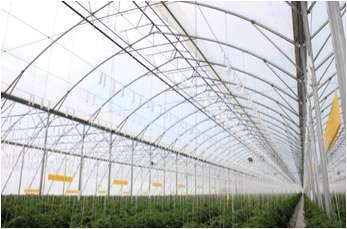Mexico: A growing market in transition
While Richel has been active on the American continent ever since the first greenhouses were built in Mexico, the French greenhouse manufacturer is expanding its presence in North America by positioning itself as a more complete solutions provider.
Herve Savoure, Sales Director Americas at Richel, sees many opportunities for greenhouse development in Mexico over the next few years. The country has become the number one supplier of fresh produce to the United States and the local greenhouse industry has seen significant growth. It is growing up and making a transition from simple tunnel and low tech production towards more dedicated high tech greenhouse production.
“Over time, a lot of things have happened here”, said Savoure when asked why Richel is such a large name in Mexico. “Fifteen years ago we arrived here just at the right time, the first growers then just started with showing interest in large scale greenhouse projects. We listened to their needs and researched the opportunities to offer them a solution that answered these requirements.”

Light levels
And the answer to those requirements was a plastic greenhouse; the structure that made Richel famous. According to Savoure, the greenhouse builder introduced the plastic greenhouse after looking more closely at the possibilities in Mexico. “After determining the light conditions and climate, we knew that a plastic greenhouse was the perfect solution for growers in Central Mexico. Mexico has some of the best light levels in the world and together with the altitude and local climate of the production areas, a plastic greenhouse makes the most sense. By providing them with the solution and right management, our customers have been able to make money and expand their businesses every 2 or 3 years. Very impressive.”
200 hectares per year
On an annual basis, Richel is responsible for the realization of 200 to 300 hectares of plastic greenhouses worldwide. Savoure said that the company is not solely devoted to building plastic greenhouses, but that for many markets plastic simply is the best choice. “We always look at each project separately and determine a solution based on our theory that analyzes the local light levels, climate and purpose in order to come up with a solution that perfectly fits those parameters, whether it is glass or plastic.”

USA
In the northern latitude like in the upper part of the USA, the light levels are much lower than in Mexico and the labor more expensive. “In this case we recommend glass greenhouse like the 8ha turn key project we built in 2014 for Red Sun Farms in Virginia.”
16 meter structure
And if the company does not have a solution available that fits those parameters or the needs of the client; then they make a solution. This was also the reason why they introduced their 16 meter bay structure in 2015.
“Mexican growers are asking for bigger and wider greenhouse structures that allow more light to enter the crop and create a better manageable climate inside. Over the last few years we have followed that trend by offering the first 8, 9.60, 12.80 and eventually the 16 meter structure. We sold 20 hectares of this new structure over the last year.”
Besides this the company has more projects going on in Mexico lately; they just finished 12 hectares for Agricola Zarattini and are currently building a 24 hectares project for San Jose y Su Agricultura. Next to this Richel is also the supplier of the structures for the expansion at Geoponica. This bell pepper grower completed 18.2 hectares this past year and is now preparing another 5 ha expansion.

Everything from A to Z
Savoure explained that many of the growers choose Richel due to their turn key approach. “Thanks to the integration of our Richel Equipment business unit we are able to deliver everything from A to Z. This is what makes us really unique, there are not many other turnkey greenhouse suppliers who manufacture their own greenhouses, both glass and plastic, and have their own engineering department to make the designs for the heating, electricity and irrigation. This allows us to have the flexibility to offer each project the best solution for the best return on investment.”